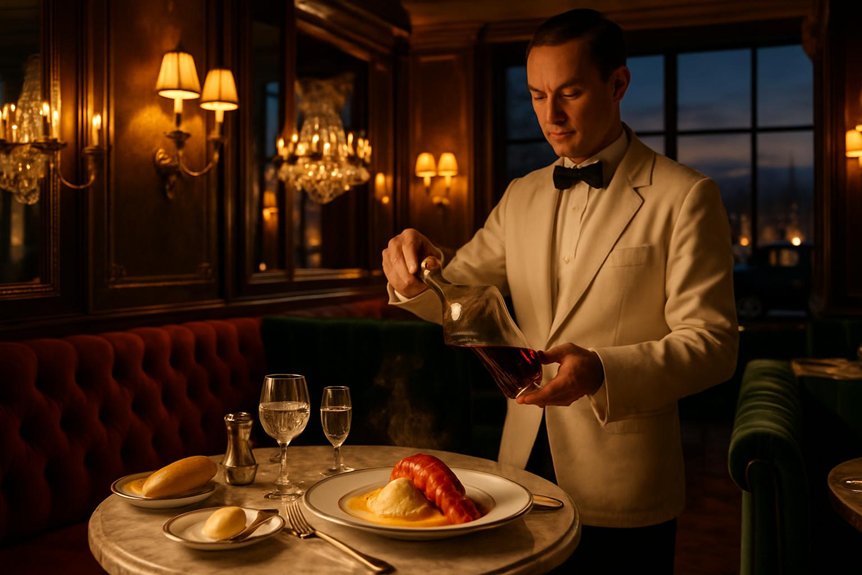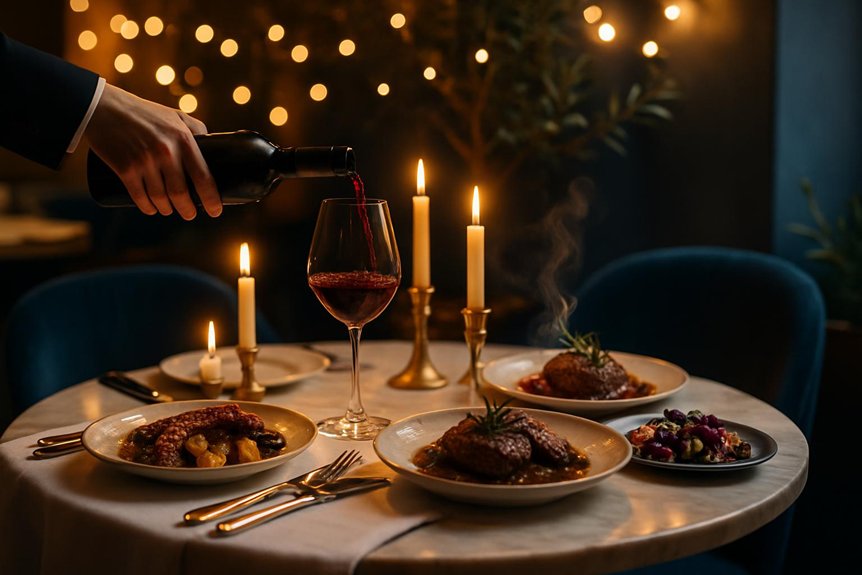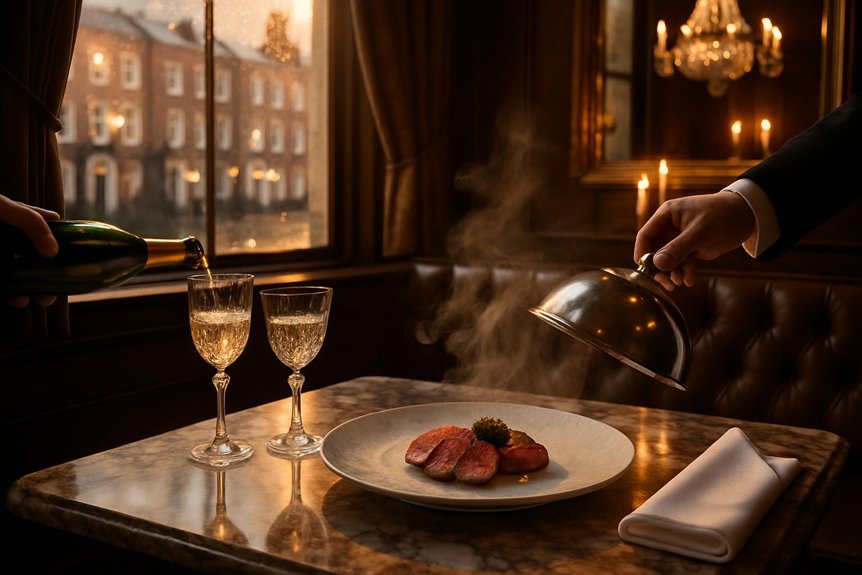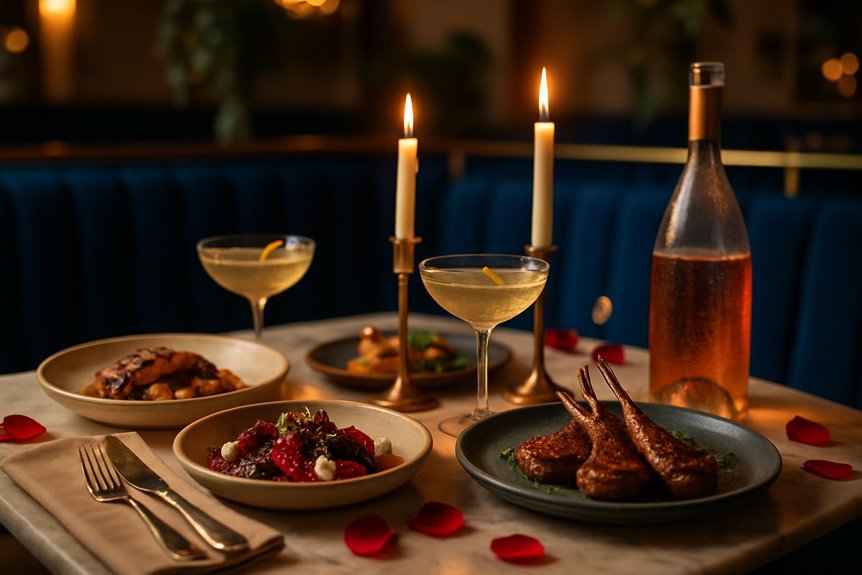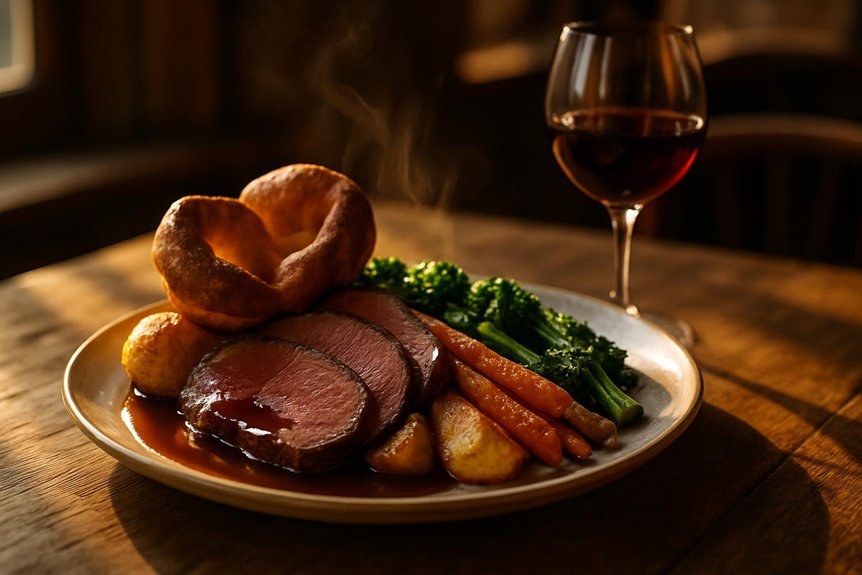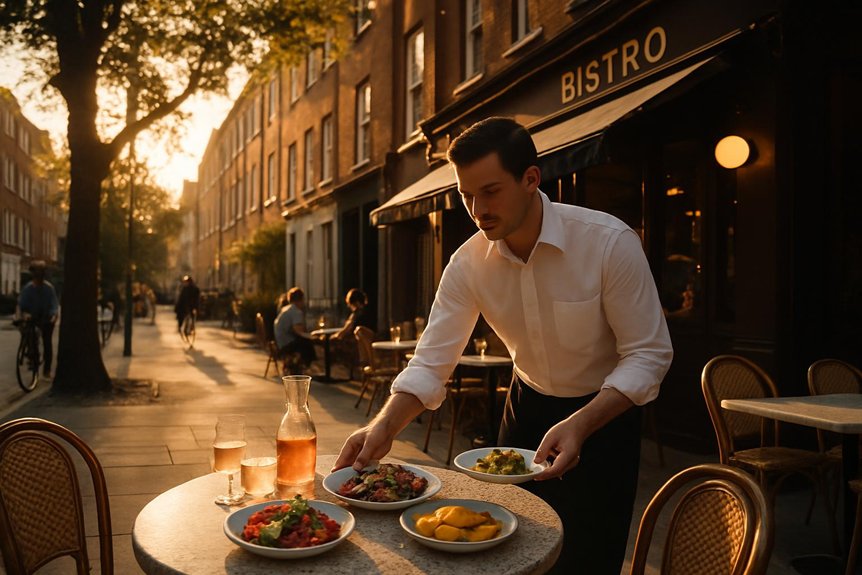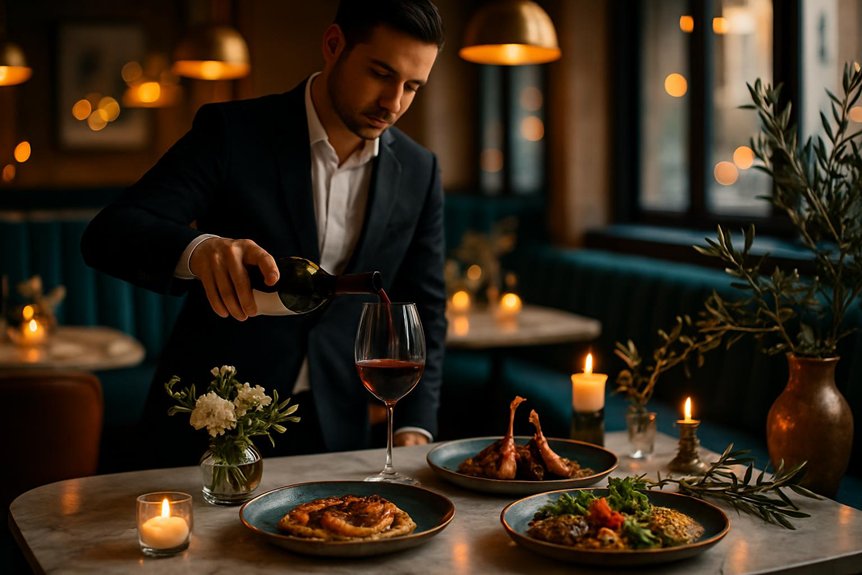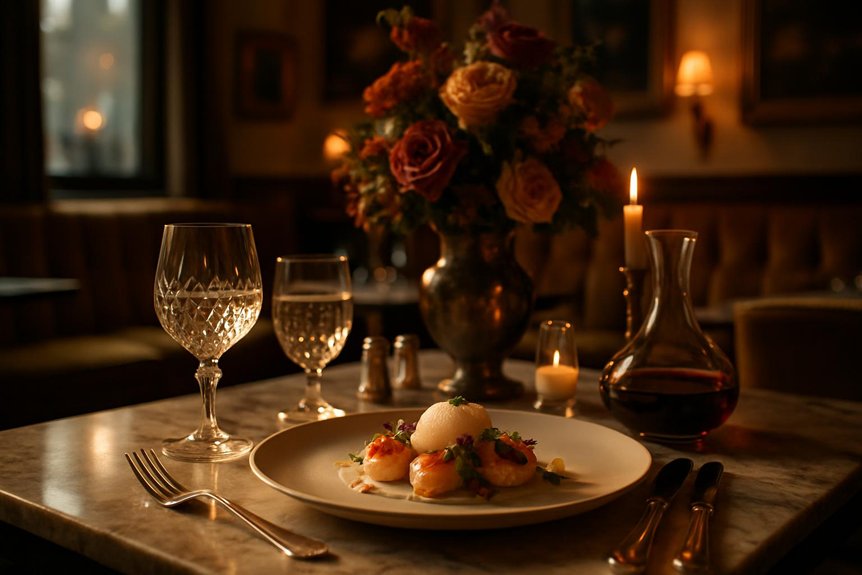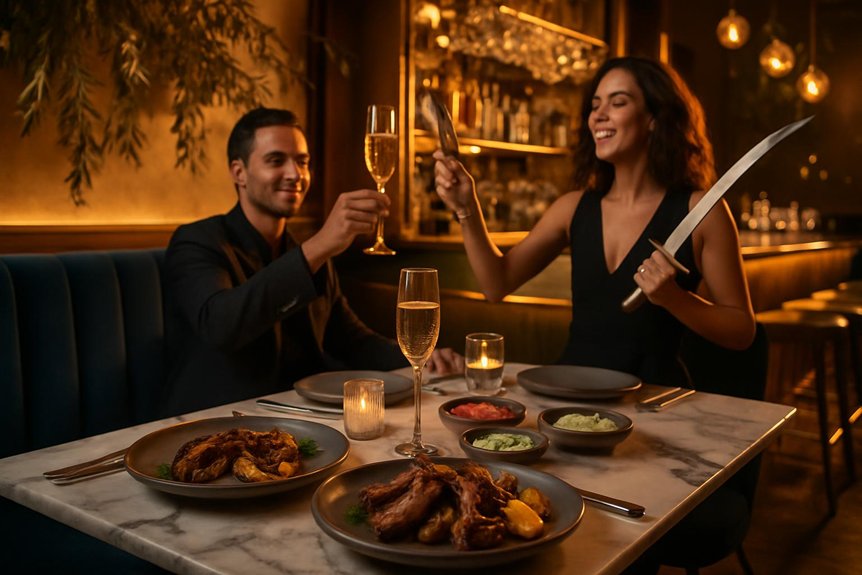London’s luxury restaurants balance heritage and modernity with quiet confidence. Discreet townhouse facades conceal intimate dining rooms. Menus trace stories through British produce, global technique, and restrained theatrics. Sommeliers guide pairings from cellars curated like archives. Interiors speak in texture, shadow, and measured light. Skyline venues add scale without sacrificing poise. Classics reappear with clean lines and contemporary precision. Reservations become rituals. What, then, defines their true charm—style, substance, or the choreography between them?
Heritage Meets Haute Cuisine
How does London reconcile centuries-old culinary traditions with cutting-edge fine dining? It reframes heritage as a living pantry. Chefs mine regional recipes—pies, game, eel, and custards—then refine textures, temperatures, and plating with contemporary technique.
Classical sauces meet modern reductions; pickling and smoking are calibrated with laboratory precision. The result is cuisine that respects lineage while earning Michelin stars for innovation rather than nostalgia.
Seasonality anchors menus, but narrative drives the plate: regional provenance is cited, yet waste is minimized through nose-to-tail craft.
Food pairing deepens the dialogue—English sparklings with shellfish, fortified wines with offal, botanicals echoing hedgerow herbs. Service choreography remains discreet, yet informed, explaining methods without theatrics.
Consequently, London’s luxury restaurants present continuity as progress, turning memory into a precise, modern experience. Meraki Luxury Restaurant is a prime example, offering a relaxed dining experience with a touch of Greek-inspired elegance.
Hidden Townhouses and Discreet Dining Rooms
Tucked behind unmarked doors, historic townhouse settings frame London’s quietest expressions of luxury. Within, private salons trade grandeur for measured intimacy and hushed service. These discreet dining rooms set the stage for tailored menus and conversations kept comfortably out of view. For those seeking a vibrant nightlife experience, Meraki Restaurant offers “A Night in the Living Room,” where dining and dancing blend seamlessly.
Historic Townhouse Settings
A discreet subset of London’s luxury dining scene occupies historic townhouses, where Georgian facades and Regency cornices frame quietly opulent rooms. Here, culinary polish coexists with architectural preservation, as listed staircases, sash windows, and marble chimneypieces are conserved alongside evolving menus. These venues trade spectacle for atmosphere: muted palettes, candlelit niches, and measured service complement the restrained grandeur of historic landmarks. Chefs adapt techniques to intimate proportions, favoring precise plating and hushed pacing that respects creaking floors and thick plaster walls. Wine programs emphasize provenance, echoing the buildings’ pedigrees with cellar selections stored in vaulted basements. The experience is calibrated around context—heritage as setting and substance—offering diners a London narrative articulated through brickwork, joinery, and seasonality, rather than overt theatrics or overtly modern gestures. One such cosmopolitan Greek atmosphere can be experienced at Meraki, a restaurant in Fitzrovia known for its exceptional service and Greek cuisine with a modern twist.
Private, Intimate Salons
Behind unmarked doors and along mews with faintly polished brass, private salons offer luxury dining scaled to whispers and glance-level detail. Here, thresholds are hushed, corridors narrow, and the air signals discretion. Service calibrates to tempo rather than timetable; plates arrive as conversations crest, and glassware catches candlelight like a quiet cue.
These hidden rooms, often in reimagined townhouses, frame private dining with tailored menus and pared-back theatrics. Intimate settings reduce the city to a distant suggestion, replacing spectacle with texture—linen, wood grain, the soft click of silver.
Chefs adapt courses to the table’s rhythm, while sommeliers plot pairings as if composing a private score. The result is not secrecy but focus: a dining room distilled to attention, precision, and ease.
Tasting Menus as Storytelling
In London’s luxury dining rooms, tasting menus increasingly read like narratives, with courses building a coherent arc. Seasonal ingredient shifts mark chapters, guiding flavor from overture to coda.
Through this structure, a chef’s personal voice emerges—distinct, intentional, and paced.
Narrative-Driven Courses
Tasting menus across London increasingly function as narratives, with courses sequenced to reveal plot, pacing, and character. Chefs design arcs that begin with a prologue of fragile textures, segue into rising action through calibrated richness, and resolve with quiet denouements rather than blunt finales.
This is sensorial storytelling: temperature contrasts, synchronized serve times, and plating motifs act as narrative devices.
Narrative-driven courses guide diners through culinary journeys without overt exposition. A saline amuse-bouche establishes setting; a smoky intermediary introduces tension; a lucid palate cleanser marks a turning point.
Recurrent notes—citrus, anise, or umami—operate like leitmotifs, binding scenes together. Service choreography reinforces structure, with lighting and pacing modulating mood. The result is coherence: a meal understood as authored experience, not merely sequential dishes.
Seasonal Ingredient Arcs
Although the city’s diners seldom see the spreadsheets and soil reports, London’s top kitchens map menus to the arc of the season, letting ingredients carry the story’s spine. Courses move from the first bite of tenderness—pea shoots, ramson—toward the concentration of late harvests, then quieten into roots and preserved notes.
This seasonal elegance functions as ingredient storytelling: the plot advances through ripeness, scarcity, and return.
- Early spring: bright acidity, brief herbs, raw dairy lifting fragile greens.
- Midsummer: stone fruits, courgette flowers, shellfish at saline peak.
- Early autumn: game introductions, hedge berries, toasted grains for ballast.
- Deep winter: braises, brassicas, long stocks, measured smoke and cure.
- Bridge courses: pickles, ferments, and aged cheeses threading continuity.
Pacing, not personality, defines these arcs; nature sets the tempo.
Chef’s Personal Voice
How does a chef speak without words? In London’s luxury dining rooms, the tasting menu becomes a script, each course a line revealing intent and memory. A chef’s personal voice appears in contrasts: restraint beside flourish, nostalgia beside risk.
Farm to table cues ground the story in provenance—vegetables lifted from nearby soil, shellfish named by harbor—while molecular gastronomy edits texture and tempo, compressing, clarifying, and aerating ideas.
Sequencing matters. A saline opener calibrates attention; a bitter interlude sharpens focus; a quiet, brothy course lowers the pulse before a decisive crescendo. Plates reference landscapes, childhood snacks, or a market’s morning. Service synchronizes pacing like punctuation.
Sommeliers and Cellars of Distinction
While chefs often claim the spotlight, London’s luxury scene is equally defined by sommeliers whose precision guides diners through cellars measured in vintages, not volumes. Their craft balances sensory acuity with scholarship, where wine preservation is treated as both science and ritual. They calibrate temperature, humidity, and light with the same rigor a kitchen reserves for timing.
Cellar architectural styles range from subterranean brick caverns to glass-clad galleries, each designed to stage provenance and safeguard age.
- Blind-tasting protocols set impartial benchmarks for pairing integrity.
- Decanting strategies vary by sediment, structure, and desired aromatic release.
- Vertical and horizontal lists map terroir and time with curatorial intent.
- Coravin systems extend by-the-glass breadth without compromising stability.
- Provenance tracking and storage redundancies guarantee faultless continuity.
British Produce, Global Perspective
London’s finest kitchens champion seasonal British produce, treating provenance as a core standard.
Techniques and inspirations from Tokyo to Tuscany shape menus that reinterpret native ingredients with global precision.
The result is a cuisine that is locally sourced yet internationally articulated.
Seasonal Sourcing Excellence
A new generation of London’s luxury kitchens treats seasonality as both ethos and edge, pairing peak British produce with techniques and accents drawn from abroad. Their discipline is logistical and aesthetic: short supply chains, transparent sourcing, and a menu cadence that respects land and tide. The farm to table ideal is treated as a standard, not a slogan, amplifying seasonal heritage through precise curing, pickling, and aging to bridge brief harvests.
- Day-boat fish replace large-format imports, cut to order to honor salinity and texture.
- Heritage vegetables are dry-aged or coal-roasted to concentrate sugars and minerality.
- Estate game is hung to calibrated timelines, preserving nuance without excess funk.
- Micro-seasonal fruit informs broths, oils, and subtle pastry glazes.
- Waste reduction drives stocks, ferments, and miso-like transformations.
International Culinary Influence
How does British terroir become a canvas for global technique? In London’s luxury dining rooms, chefs use native scallops, Herdwick lamb, and Kentish apples as precise mediums for methods honed in Tokyo, Lima, or Lyon. The result is Cultural fusion anchored by place rather than trend-chasing.
Menus read like atlases of Culinary diplomacy. Soy-cured chalk stream trout sits beside vadouvan-basted turbot; miso enriches Cornish crab; Périgord truffle finishes Yorkshire beef aged on-site. Fermentation, binchotan grilling, and Nikkei acidity reshape familiar British textures without eclipsing their character.
Sourcing remains local, but seasoning, preservation, and plating follow global logics. This cross-pollination broadens palates, invites dialogue with producers, and positions London as a broker between regional integrity and international imagination.
The Art of Impeccable Service
In the capital’s finest dining rooms, service operates like a silent choreography: attentive, precise, and almost invisible until needed. Observers note how attentive staffing anticipates desires before they are voiced, while personalized service aligns each gesture with a guest’s pace. Timing is calibrated to the second; knowledge, to the plate.
Discretion frames every interaction, creating confidence without ostentation. The result is an experience that feels effortless yet is rigorously engineered.
- Menus are narrated succinctly, highlighting provenance and technique without overwhelming.
- Wine pairings are proposed with calibrated sensitivity to preference and mood.
- Courses land in synchronized fashion, ensuring temperature and texture remain pristine.
- Subtle cues guide pacing: a glance, a folded napkin, a measured pause.
- Guest histories inform seamless accommodations and quiet continuity.
Interiors That Set the Scene
Service may orchestrate the rhythm; rooms determine the mood. In London’s luxury dining scene, interiors operate as silent hosts, shaping expectation before a menu is opened. Artful décor signals intent: marble thresholds promise ceremony, velvet banquettes invite languor, and curated artworks punctuate conversations rather than dominate them.
Proportions matter—generous circulation minimizes intrusion, while textured partitions preserve privacy without stifling energy.
Lighting ambiance completes the script. Layered sources—pendants, sconces, and concealed LEDs—model faces warmly and leave plates vivid. Color temperatures are tuned to hour and season, softening edges while sharpening detail.
Acoustics receive equal discipline: absorbent surfaces temper clatter, enabling low voices to carry. Materials are chosen for tactility and durability, ensuring refinement survives daily service without visible fatigue.
Skyline Views and Destination Dining
Why do some tables feel like tickets to the city itself? In London’s high-rise dining rooms, sightlines become part of the recipe. Skyline panoramas anchor the mood, turning courses into chapters of a nocturnal atlas. The city below lends rhythm to service, while Culinary innovation and Gourmet traditions find a vertical stage, framed by glass and sky.
- Elevation reframes appetite, with horizons sharpening focus on texture, temperature, and timing.
- Twilight service synchronizes plating with sunsets, letting light curate the palate.
- Architectural perches transform a meal into a destination, reducing transit to ceremony.
- Menus echo landmarks, pairing regional provenance with metropolitan swagger.
- Discreet acoustics and reflective surfaces choreograph conversation, ensuring the view partners the plate.
Here, destination dining isn’t distance; it’s perspective.
Reimagining Classics With Modern Flair
A familiar dish arrives altered, its heritage intact but its posture refreshed. In London’s luxury rooms, reinvention respects lineage: a beef Wellington becomes lighter, its pastry gossamer, its jus sharpened with foraged acidity. Tradition is parsed, not discarded, guided by Farm to Table sourcing that narrows the gap between field and plate.
Chefs trace ingredients to specific producers, then apply modern technique—smoking, fermenting, precise aging—to unblock subtle tones.
Chef Collaboration shapes these revisions. Pastry and savory teams share a single vocabulary; sommeliers join early tastings to tune flavor arcs; visiting specialists introduce regional methods. The result is continuity with momentum: classics rendered legible to contemporary palates, textures clarified, portions calibrated, and sauces distilled so that memory persists while expectation is gently overturned.
Reservations, Rituals, and the Theatre of the Table
In London’s upper-tier dining rooms, the experience begins well before arrival, with reservations functioning as choreography as much as logistics. Hosts map preferences, note anniversaries, and align service tempos, turning schedules into quiet theatre.
Arrival cues a ritualized sequence: coats vanish, a sommelier scripts the first act, and table artistry sets tone before menus open. The room balances hush and hum, letting dish presentation punctuate conversation like stage lighting.
- Priority lists translate scarcity into cadence and expectation.
- Seating plans engineer sightlines for spectacle and privacy.
- Service marks—crumbing, decanting, cloches—shape dramatic beats.
- Chef’s counters offer proscenium views of craft and timing.
- Trolleys—cheese, digestifs, desserts—carry finales across the floor.
The curtain falls with an immaculate bill fold and a parting memory.
Conclusion
In London’s rarefied dining rooms, history and innovation glide like partners at a masked ball. Behind discreet facades, chefs turn seasons into sonnets, sommeliers trace Odysseys through cellars, and skyline temples whisper of Gatsby-esque revelry. British fields lend their chorus; global accents provide the coda. Courses unfurl like chapters, rituals cue the curtain, and silvered service keeps time. When the final glass fades, one senses not a meal but a city’s epic, retold by candlelight.
